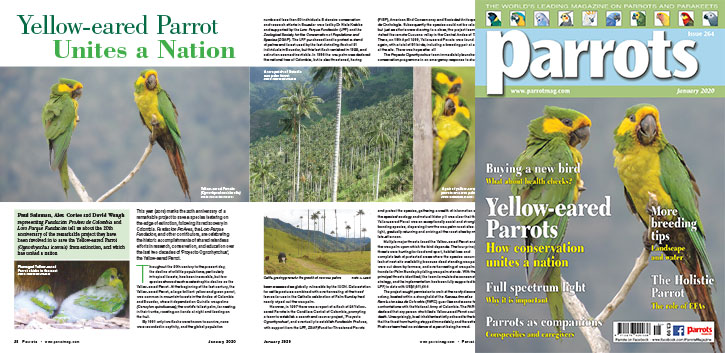
By Paul Salaman, Alex Cortes and David Waugh
This year (2019) marks the 20th anniversary of a remarkable project to save a species teetering on the edge of extinction, following its rediscovery in Colombia. Fundación ProAves, the Loro Parque Fundación, and other contributors, are celebrating the historic accomplishments of shared relentless efforts in research, conservation, and education over the last two decades of ‘Proyecto Ognorhynchus’, the Yellow-eared Parrot.
Throughout the 20th century to the present day, the decline of wildlife populations, particularly in tropical forests, has been inexorable, but few species showed such a catastrophic decline as the Yellow-eared Parrot. At the beginning of the last century, the Yellow-eared Parrot, a large brilliant yellow and green parrot, was common in mountain forests in the Andes of Colombia and Ecuador, where it depended on Quindío wax palms (Ceroxylon quindiuense), the world’s tallest palm, for nesting in their trunks, roosting on fronds at night and feeding on the fruit.
By 1991 only two flocks were known to survive, none were recorded in captivity, and the global population numbered less than 50 individuals. Extensive conservation and research efforts in Ecuador were led by Dr Niels Krabbe and supported by the Loro Parque Fundación (LPF) and the Zoological Society for the Conservation of Populations and Species (ZGAP). The LPF purchased land to protect a stand of palms and forest used by the last dwindling flock of 21 individuals in Ecuador, but this last flock vanished in 1998, and extinction seemed inevitable. In 1986 the wax palm was declared the national tree of Colombia, but is also threatened, having been assessed as globally vulnerable by the IUCN. Deforestation for cattle pastures combined with overharvesting of the trees’ leaves for use in the Catholic celebration of Palm Sunday had nearly wiped out the wax palm.








Parrot Chat
Buyers Guides
Breeding articles